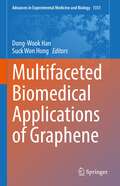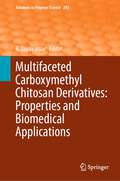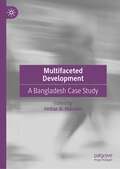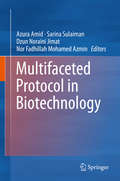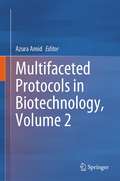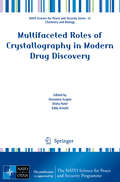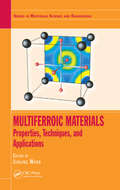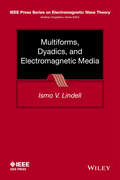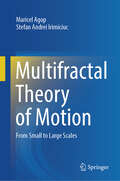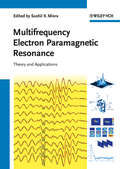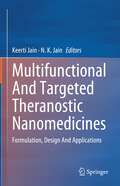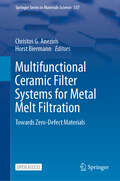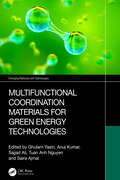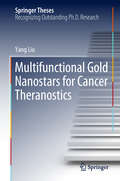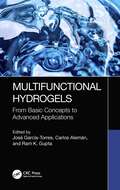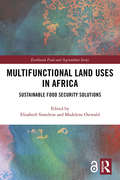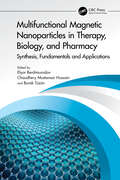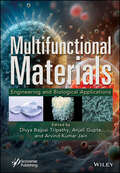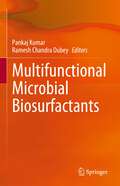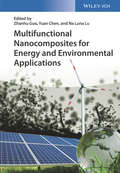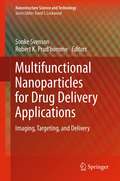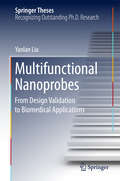- Table View
- List View
Multifaceted Biomedical Applications of Graphene (Advances in Experimental Medicine and Biology #1351)
by Dong-Wook Han Suck Won HongThis book explains the fundamental characteristics and biofunctionality of graphene-based nanomaterials and provides up-to-date information on the full range of their biomedical applications. An introductory section gives an overview of the chemical composition and physical properties of graphene and its derivatives as well as their potential toxicity and biosafety. Detailed attention is then devoted to the potential of multifunctional graphene-based nanomaterials (MFGNs) to direct the differentiation of stem cells into specific lineages and induce tissue regeneration. Here, individual chapters address the application of MFGNs for the purposes of neurogenesis, osteo- and chrondrogenesis, myogenesis, and wound healing. Subsequent sections focus on the capability of MFGNs as agents for drug delivery, bioimaging, theranostics, and therapeutics as well as their effectiveness as biomimetic platforms for nanobiosensors, biochips, medical devices, and dental applications. The book will be essential reading for graduate students, scientists, and engineers in any of the biomedical research fields in which efforts are being made to utilize novel MFGN-incorporated composite materials and develop functional devices based on them.
Multifaceted Carboxymethyl Chitosan Derivatives: Properties and Biomedical Applications (Advances in Polymer Science #292)
by R. JayakumarThis edited collection deals with the structure-property relationships and biomedical applications of carboxymethyl chitosan derivatives in different fields. Readers will detailed overview of the preparatory methods involved in the derivatives of carboxymethyl chitosan and its interaction with metal ions. The chapters provide a detailed overview of the different types of carboxymethyl chitosan derivatives, including the preparatory methods involved, the interactions with metal ions, and the antimicrobial activities. These different forms of carboxymethyl chitosan derivatives are found to be potentially used in food packaging, in enhancing saltiness, as biosensors, and also as wound dressing. Chapters are also devoted to the fabrication and biomedical applications of carboxymethyl chitosan derivatives-based nanofibers as well as the interaction of carboxymethyl chitosan with blood in blood clotting and the underlying mechanism. Contributing authors additionally explore topics related to carboxymethyl chitosan-based hydrogels, films, scaffolds, fibers, and composites. Finally, this volume presents the current challenges in developing biomedical products based on carboxymethyl chitosan derivatives. This book will be of interest not only to chemists, but to all scientists working in the fields of material/environmental science, biological science, and biomaterials. These chapters are great resources for any researcher who works with structure-property relationships, biological interactions, and the applications of carboxymethyl chitosan derivatives in different biomedical fields.
Multifaceted Development: A Bangladesh Case Study
by Imtiaz A. HussainThis book focuses on the modernization of Bangladesh. It does so by including case studies at the national and sub-national government levels and comparative studies with other countries.Chapters in the book highlight how a number of aspects have been affected in the modernization process, such as the adoption of ‘western’ curriculum and English language in schools, the use of animation to boost school student comprehension of texts, the rural–urban divide, pedagogical training to emergent andragogy-dependent market needs, converting ‘local ’ shipping experiences to fill growing ‘global ’ needs, and multilateral environmental adaptation and mitigation mandates being adopted ‘locally.’
Multifaceted Protocol in Biotechnology
by Azura Amid Sarina Sulaiman Dzun Noraini Jimat Nor Fadhillah AzminThis edited work presents useful methods in experimenting in the area of Bioprocessing and Biotechnology. The four sections cover the area of Bioprocess, Whole Cells & Isolated Biocatalyst, Characterization of Biochemical Products and Cell Isolation & Culture. Its enable researchers to choose a suitable method and plan their experiments in details. The main focus of this book is to provide step by step method to young researchers, especially in the new research areas. Among the latest areas are the isolation of novel strain or enzyme by metagenomic approaches and taming procedure in the laboratories, development of novel, the cheap and non-toxic catalyst for biodiesel production, and production of micro-fibrillated cellulose. An updated method for well-known areas such as immobilization technology, biosensor, and polymerization was also presented. The book also covers in-silico methods such as MATLAB platform to ease researchers. Not to forget, the method in animal and plant culture is also discussed in detail.The book is written by chapter authors with much expertise in their fields. They have published multiple articles in the index listed journals.The topic of this book is particularly relevant to young researchers who are struggling to fine-tune their research and do not want to waste their time in optimizing the experiment set up.
Multifaceted Protocols in Biotechnology, Volume 2
by Azura AmidThis contributed volume, “Multifaceted Protocols in Biotechnology, Volume 2”, consists of multidisciplinary methods and techniques commonly used in biotechnology studies. There are two sections covered in this book – Ionic Liquid Related Techniques & Evergreen Biotechnology Techniques. A brief introduction supports each protocol to allow easy learning and implementation. The first section consists of three chapters covering studies in modern biotechnology focusing on the role of ionic liquid techniques in extracting secondary metabolites, enzyme stabilization and biomass processing. The second section covers evergreen methodologies. It comprises five chapters covering topics on microcarrier technology for cell culture; Polymerase Chain Reaction for non-halal sources detection in food; ELISA for biomarker identification; gamma ray-induced mutagenesis for enhancing microbial fuel cells; and the effect of temperature on antibacterial activity of Carica papaya seed extract. This book will be useful to graduate students, researchers, academics, and industry practitioners working in the area of biotechnology
Multifaceted Roles of Crystallography in Modern Drug Discovery
by Giovanna Scapin Disha Patel Eddy ArnoldThe present work offers a snapshot of the state-of-the-art of crystallographic, analytical, and computational methods used in modern drug design and development. Topics discussed include: drug design against complex systems (membrane proteins, cell surface receptors, epigenetic targets, and ribosomes); modulation of protein-protein interactions; the impact of small molecule structures in drug discovery and the application of concepts such as molecular geometry, conformation, and flexibility to drug design; methodologies for understanding and characterizing protein states and protein-ligand interactions during the drug design process; and monoclonal antibody therapies. These methods are illustrated through their application to problems of medical and biological significance, such as viral and bacterial infections, diabetes, autoimmune disease, and CNS diseases. As approaches to drug discovery have changed over time, so have the methodologies used to solve the varied, new, and difficult problems encountered in drug discovery. In recent years we have seen great progress in the fields of genetics, biology, chemistry, and medicine, but there are still many unmet medical needs, from bacterial infections to cancer to chronic maladies, that require novel, different, or better therapies. This work will be of interest to researchers and policy makers interested in the latest developments in drug design.
Multiferroic Materials: Properties, Techniques, and Applications (Series in Materials Science and Engineering)
by Junling Wang"a very detailed book on multiferroics that will be useful for PhD students and researchers interested in this emerging field of materials science" —Dr. Wilfrid Prellier, Research Director, CNRS, Caen, France Multiferroics has emerged as one of the hottest topics in solid state physics in this millennium. The coexistence of multiple ferroic/antiferroic properties makes them useful both for fundamental studies and practical applications such as revolutionary new memory technologies and next-generation spintronics devices. This book provides an historical introduction to the field, followed by a summary of recent progress in single-phase multiferroics (type-I and type-II), multiferroic composites (bulk and nano composites), and emerging areas such as domain walls and vortices. Each chapter addresses potential technological implications. There is also a section dedicated to theoretical approaches, both phenomenological and first-principles calculations.
Multiforms, Dyadics, and Electromagnetic Media
by Ismo V. LindellThis book applies the four-dimensional formalism with an extended toolbox of operation rules, allowing readers to define more general classes of electromagnetic media and to analyze EM waves that can exist in them End-of-chapter exercises Formalism allows readers to find novel classes of media Covers various properties of electromagnetic media in terms of which they can be set in different classes
Multifractal Theory of Motion: From Small to Large Scales
by Maricel Agop Stefan Andrei IrimiciucThis book aims to present the topic of nonlinear and chaotic dynamics in a manner that is useful and beneficial to students and young researchers from various domains such as physics, mathematics, biology, or even medicine. A very important aspect of that topic is that the constraints of determinism do not imply a regular behavior or do not rely on predictability in describing the dynamics of natural systems. Exploring the evolution of natural systems has a great impact nowadays on a wide range of scientific domains. The dynamics of populations, cardiac fibrillation, communication systems, fluid flow, and atmospheric systems are just a few topics in which nonlinearity and chaos are a regular manifestation. This leads to the idea that it is necessary to find universal laws that govern these dynamics. The aforementioned variety in scientific topics is also sustained by an exponential interest in recent decades from readers in the scientific community and the non-scientific one as well. The book is devoted to the nonlinear and chaotic dynamics topic, a domain that is both trans- and multi-disciplinary and has been the focus of the scientific community in past decades.
Multifrequency Electron Paramagnetic Resonance: Theory and Applications
by Sushil K. MisraFilling the gap for a systematic, authoritative, and up-to-date review of this cutting-edge technique, this book covers both low and high frequency EPR, emphasizing the importance of adopting the multifrequency approach to study paramagnetic systems in full detail by using the EPR method. In so doing, it discusses not only the underlying theory and applications, but also all recent advances -- with a final section devoted to future perspectives.
Multifunctional And Targeted Theranostic Nanomedicines: Formulation, Design And Applications
by N. K. Jain Keerti JainThis book discusses approaches based on multifunctional and targeted theranostic nanomedicines for improving diagnosis and drug delivery. It explores nanomedicines based on nanocarriers like liposomes, ethosomes, niosomes, polymeric nanoparticles, lipidic nanoparticles, metallic nanoparticles, micelles, dendrimers, quantum dots, carbon-based nanomaterials including carbon nanotubes, carbon dots, carbon quantum dots, graphene oxide, and fullerene. This book reviews designing, conjugation, optimization, formulation and development, and scale-up of multifunctional and targeted theranostic nanomedicines. It examines major challenges in developing nanomaterials that can be applied to nanomedicine with high biocompatibility and biodegradability for diagnostic and therapeutic purposes. Lastly, it addresses the most promising approaches at both commercialization and regulatory steps for bringing theranostic nanomedicine from research laboratories to clinics for patient use.
Multifunctional Ceramic Filter Systems for Metal Melt Filtration: Towards Zero-Defect Materials (Springer Series in Materials Science #337)
by Horst Biermann Christos G. AnezirisThis open access book covers novel techniques and materials for removing inclusions in metallic melts, resulting in significant improvements to the purity, quality, and materials properties of the cast metal product. It looks at an entirely new generation of intelligent filter materials and filter systems with functionalized surfaces for removing solid and liquid inclusions such as deoxidation products, sulfides, and nitrides carbide from metallic melts. This collection of contributed chapters addresses the overarching goal of the production of lightweight structures and high-demand construction materials within an overall substantially cleaner and more sustainable global supply chain. The chapters cover a diverse array of topics ranging in scope from the development of ceramic foam filters, to in-situ x-ray and optical characterization techniques, as well as advanced modelling of 3D-printed filter structures. Additionally, the book features a number of contributions directly transferable to industrial applications related to the clean metal casting technologies of aluminium and steel alloys.
Multifunctional Coordination Materials for Green Energy Technologies (Emerging Materials and Technologies)
by Anuj Kumar Tuan Anh Nguyen Ghulam Yasin Sajjad Ali Saira AjmalAs an emerging material platform, multifunctional coordination materials offer many advantages such as remarkable porosity, structural flexibility, crystallinity, and modifiable functionalities that render them highly suited to generate and store green energy. This book covers the design and fabrication approaches of multifunctional coordination materials for green energy-related technologies, including batteries, supercapacitors, solar cells, and nanogenerators. Discusses fundamentals of multifunctional coordination materials Explains vital synthesis and design techniques as well as theoretical modeling Offers a comprehensive overview of preparation, structural and morphological properties, and applications in a wide variety of energy production, energy storage, and energy device technologies Assesses environmental impacts, recycling, challenges, and future perspectives Multifunctional Coordination Materials for Green Energy Technologies is an ideal reference for advanced students and researchers working in materials engineering, including new catalyst development, battery design, and related areas.
Multifunctional Gold Nanostars for Cancer Theranostics (Springer Theses)
by Yang LiuThis thesis presents the development of theranostic gold nanostars (GNS) for multimodality cancer imaging and therapy. Furthermore, it demonstrates that a novel two-pronged treatment, combining immune-checkpoint inhibition and GNS-mediated photothermal nanotherapy, can not only eradicate primary treated tumors but also trigger immune responses to treat distant untreated tumors in a mouse animal model. Cancer has become a significant threat to human health with more than eight million deaths each year, and novel methods for cancer management to improve patients’ overall survival are urgently needed. The developed multifunctional GNS nanoprobe with tip-enhanced plasmonics in the near-infrared region can be combined with (1) surface-enhanced Raman spectroscopy (SERS), (2) two-photon photoluminescence (TPL), (3) X-ray computed tomography (CT), (4) magnetic resonance imaging (MRI), (5) positron emission tomography (PET), and (6) photothermal therapy (PTT) for cancer imaging and treatment. The ability of the GNS nanoprobe to detect submillimeter intracranial brain tumors was demonstrated using PET scan – a superior non-invasive imaging modality – in a mouse animal model. In addition, delayed rechallenge with repeated cancer cell injection in cured mice did not lead to new tumor formation, indicating generation of a memorized immune response to cancer. The biocompatible gold nanostars with superior capabilities for cancer imaging and treatment have great potential for translational medicine applications.
Multifunctional Hydrogels: From Basic Concepts to Advanced Applications
by Carlos Alemán Ram K. Gupta José García-TorresHydrogels are important polymer-based materials with innate fascinating properties and applications: they are three-dimensional, hydrophilic, polymeric networks that can absorb large amounts of water or aqueous fluids and are biocompatible, mechanically flexible, and soft. The incorporation of functionalities to develop smart and bioactive platforms has led to a myriad of applications. This book offers a comprehensive overview of multifunctional hydrogels, covering fundamentals, properties, and advanced applications in a progressive way. While each chapter can be read stand-alone, together they clearly describe the fundamental concepts of design, synthesis, and fabrication, as well as properties and performances of smart multifunctional hydrogels and their advanced applications in the biomedical, environmental, and robotics fields.This book:• Introduces readers to different hydrogel materials and the polymer types used to fabricate them.• Discusses conducting polymer hydrogels, nanocomposite hydrogels, and self-healing hydrogels.• Covers synthesis methodologies and fabrication techniques commonly used to confer certain structures and/or architectures.• Shows how hydrogels can be modified to incorporate new functionalities able to respond to physical and/or chemical changes.• Examines applications including bioelectronics, sensors and biosensors, tissue engineering, drug delivery, antipathogen applications, cancer theranostics, environmental applications, and soft robotics, with chapters showcasing the main advances achieved up to date in every field.Multifunctional Hydrogels: From Basic Concepts to Advanced Applications serves as a valuable resource for academic and industry researchers from interdisciplinary fields including materials science, chemistry, chemical engineering, bioengineering, physics, and pharmaceutical engineering.
Multifunctional Land Uses in Africa: Sustainable Food Security Solutions (Earthscan Food and Agriculture)
by Elisabeth Simelton Madelene OstwaldThis book presents contemporary case studies of land use, management practices, and innovation in Africa with a view to exploring how multifunctional land uses can alleviate food insecurity and poverty. Food security and livelihoods in Africa face multiple challenges in the form of feeding a growing population on declining land areas under the impacts of climate change. The overall question is what kind of farming systems can provide resilient livelihoods? This volume presents a selection of existing farming systems that demonstrate how more efficient use of land and natural resources, labour and other inputs can have positive effects on household food security and livelihoods. It examines how aquaculture, integrated water management, peri-urban farming systems, climate-smart agriculture practices and parkland agroforestry contribute multiple benefits. Drawing on case studies from Kenya, Ethiopia, Nigeria and Burkina Faso, contributed by young African scientists, this book provides a unique perspective on multifunctional land use in Africa and illustrates how non-conventional uses can be profitable while promoting social and environmental sustainability. Tapping into the global discussion on land scarcity and linking food security to existing land use change processes, this volume will stimulate readers looking for diversified land uses that are compatible with both household and national food security ambitions. This book will be of great interest to students and scholars of African development, agriculture, food security, land use and environmental management, as well as sustainable development more generally, in addition to policymakers and practitioners working in these areas.
Multifunctional Magnetic Nanoparticles in Therapy, Biology, and Pharmacy: Synthesis, Fundamentals and Applications
by Chaudhery Mustansar Hussain Elyor Berdimurodov Burak TüzünThis definitive guide provides readers with an overview of multifunctional nanoparticles, delving into their novel synthesis methods, unique properties, and diverse applications in therapy, biology, and pharmacy. It also explores techniques for synthesizing magnetic nanoparticles and explains how to tailor nanoparticles with desired traits.Multifunctional Magnetic Nanoparticles in Therapy, Biology, and Pharmacy: Synthesis, Fundamentals and Applications, explores established and emerging techniques for synthesizing magnetic nanoparticles, enabling readers to understand how to tailor-make nanoparticles with desired traits. Beginning with fundamentals, leading experts delve into topics like recent trends in nanoparticle fabrication, magnetic properties, drug delivery systems, imaging, sensing, separation techniques, toxicity mitigation, and commercial applications. The book showcases the transformative impact and future possibilities of multifunctional magnetic nanoparticles in therapy, biology, and pharmacy. It elucidates the fundamentals behind their magnetic properties and interactions, empowering the development of innovative applications. Detailed chapters highlight their utilization in hyperthermia, cancer therapies, separation and detection of biological molecules and cells, as biocatalysts and in bionanotechnology, antimicrobial agents, sensors, and more.This book is written primarily for scientists, researchers, and engineers working in the fields of nanotechnology, materials science, biomedical engineering, and pharmaceutical sciences. The book covers core principles as well as practical applications, which makes it a valuable textbook or training resource across academic and professional settings in this field.
Multifunctional Materials: Engineering and Biological Applications
by Arvind Kumar Jain Divya Bajpai Tripathy Anjali GuptaThis comprehensive book is essential for anyone looking to deepen their understanding of advanced materials and their transformative impact across multiple disciplines, from cutting-edge technologies to innovative solutions in engineering and biology. Multifunctional Materials: Engineering and Biological Applications is a comprehensive guide on advanced materials, a class of materials that exhibit novel properties, high performance, and unique functionalities that make them suitable for a wide range of applications. These materials are typically engineered at the molecular or atomic level, allowing precise control over their structure and properties. The field of advanced materials is vast, covering a range of material types and applications. This volume covers topics on the chemistry, properties, and applications of advanced materials. The study of advanced materials involves multiple disciplines, including materials science, chemistry, physics, and engineering. Advances in this field have led to the development of new and improved technologies, such as high-efficiency solar cells, lightweight and strong materials for aerospace applications, and new drug delivery systems for disease treatment. The volume: Demonstrates materials synthesis and characterization of multifunctional materials; Examines properties and functionalities of multifunctional materials, such as mechanical, electrical, and thermal properties, as well as other functional properties; Outlines multifunctional materials applications, including their use in biomedical devices, aerospace and defense systems, and consumer electronics; Provides a comprehensive overview of this rapidly evolving field, covering topics related to materials science, engineering, and technology. Audience Researchers, industry scientists and engineers, academics, and postgraduate students working in the fields of materials chemistry, applied chemistry, nanotechnology, chemical technology, polymer science and engineering, and industrial chemistry.
Multifunctional Microbial Biosurfactants
by Pankaj Kumar Ramesh Chandra DubeyThis book provides an overview of biosurfactants as biobased compounds, and highlights novel applications in several industries, including biotech, food processing, cosmetic, oil recovery/petroleum, pharmaceutical, detergent and textile. In the past few decades, biosurfactants have emerged as promising alternative surface-active agents to chemical surfactants due to their high biodegradability, low toxicity, multi-functionality under extreme pH and temperature conditions, long-term physicochemical stability, and their production from renewable sources. This book presents the fundamental aspects (classification, structure, genetics, and properties) of biosurfactants and how their features contribute to the global bioeconomy. Chapters from expert contributors discuss the latest screening, purification and characterization methods of new biosurfactants and biosurfactant-producing fungi and bacteria, including extremophiles. Particular attention is given to the role of biosurfactants in the formulation of sustainable agrochemicals, and their application as eco-friendly mosquitocidal agents, and biopesticides. Readers will discover a perspective on the antiviral activity of biosurfactants, in which the latest in vitro and in silico studies are discussed. Readers will also find more about the foremost therapeutic attributes of biosurfactant-mediated nanoparticles as next-generation drug delivery systems. Given its breadth, this book appeals to a wide readership, from students and academic researchers to scientists and professionals from industry, interested in the study and application of microbial surfactants.
Multifunctional Nanocomposites for Energy and Environmental Applications
by Zhanhu Guo Yuan Chen Na Luna LuFocusing on real applications of nanocomposites and nanotechnologies for sustainable development, this book shows how nanocomposites can help to solve energy and environmental problems, including a broad overview of energy-related applications and a unique selection of environmental topics. Clearly structured, the first part covers such energy-related applications as lithium ion batteries, solar cells, catalysis, thermoelectric waste heat harvesting and water splitting, while the second part provides unique perspectives on environmental fields, including nuclear waste management and carbon dioxide capture and storage. The result is a successful combination of fundamentals for newcomers to the field and the latest results for experienced scientists, engineers, and industry researchers.
Multifunctional Nanoparticles for Drug Delivery Applications
by Robert K. Prud'Homme Sonke SvensonThis book clearly demonstrates the progression of nanoparticle therapeutics from basic research to applications. This book, unlike others covering nanoparticles used in medical applications, presents the medical challenges that can be reduced or even overcome by recent advances in nanoscale drug delivery. Each chapter highlights recent progress in the design and engineering of select multifunctional nanoparticles with topics covering targeting, imaging, delivery, diagnostics, and therapy.
Multifunctional Nanoprobes
by Yanlan LiuThis thesis mainly focuses on the design and synthesis of novel multifunctional nanoprobes, investigating their feasibility for applications involving sensing, molecular imaging, and the simultaneous diagnosis and therapy of cancer. Above all, it discusses the development of innovative nanomaterials to address the issues limiting the effectiveness of currently available nanoprobes such as the synthesis shortcoming and poor performance in sensing, imaging and therapeutic applications. One of the strengths of this thesis is its integration of knowledge from chemistry, materials science and biomedicine. Further, it presents the theoretical fundamentals in the design of nanoprobes, which can offer guidance for future studies on the development of novel multifunctional nanomaterials with significantly enhanced performance.
Multifunctional Nanostructured Metal Oxides for Energy Harvesting and Storage Devices
by Vijay B. Pawade Bharat A. Bhanvase Paresh H. SalameMetal oxide nanoparticles exhibit potential applications in energy and environmental fields, such as solar cells, fuel cells, hydrogen energy, and energy storage devices. This book covers all points from synthesis, properties, and applications of transition metal oxide nanoparticle materials in energy storage and conversion devices. Aimed at graduate-level students and researchers associated with the energy and environment sector, this book addresses the application of nontoxic and environmentally friendly metal oxide materials for a clean environment and deals with synthesis properties and application metal oxides materials for energy conversion, energy storage, and hydrogen generation.
Multifunctional Sensors: Design, Construction, Methodology and Uses (Series in Sensors)
by Joyanta Kumar Roy Bansari Deb MajumderThis book provides a detailed overview of multifunctional sensors, covering discussions on different types of multifunctional sensors developed in past years. As a case study, the development of admittance-type multifunctional sensors is provided, constituting its construction, working principles, measurements, and instrumentation used. It also explores a review of the research in the field from 1990 to 2022. It will be a useful resource for researchers of sensor technologies across physics, engineering, and other physical sciences. Key Features • Presents a case study of a multifunctional sensor that measures temperature and level simultaneously. • Discusses latest trends in the area and can be understood by advanced students up to research level scholars. • Looks ahead to the future of these sensors for further research opportunities.
Multifunctional Ultrawideband Antennas: Trends, Techniques and Applications
by Chinmoy Saha Jawad Y Siddiqui Y M AntarMultifunctional Antennas (MFA) are comparatively a new area for antenna research and finds applications in various modern wireless radios, like Cognitive Radio (CR) in Software Defined Radio (SDR) technology and MIMO technology. This book is first attempt and an invaluable resource which deals with the design and realization of various kinds of multifunctional antennas. After clearly explaining the exclusive features of MFAs, the book presents various designs of such antennas considering versatile modern and upcoming applications. <li>Written by three internationally known researchers, Multi-Functional Ultra Wideband Antennas: Trends, Techniques and Applications: <li>Provides a lucid introduction on UWB systems, historical perspective and discusses various applications of such systems <li>Discusses fundamentals of antennas and its characterization in time and frequency domains, primarily aimed for the beginners in the area <li>Revisits the design and realization of various classical UWB antennas <li>Discusses various techniques of designing frequency-notched UWB antennas and provide detailed comparison of the techniques <li>Deals with the techniques of deriving multiple antenna functionalities from a single antenna <li>Incorporates exclusive discussions on modern reconfigurable antennas and printed and dielectric resonator based MIMO antennas with clear focus on recent and upcoming technological requirements <P><P>With Multi-Functional Ultra Wideband Antennas: Trends, Techniques and Applications, antenna engineers, communication system engineers, graduate students, academic/industry researchers will gain a thorough knowledge on design of such antennas with clear physical insight and understanding. <P><P> Chinmoy Saha, PHD, is an associate Professor in the Department of Avionics at Indian Institute of Space Science and Technology, Thiruvananthapuram, Kerala, India. His current research interest includes Microwave Circuits, Engineered Materials, Metamaterial Inspired Antennas and Circuits, reconfigurable and multi-functional antennas for modern wireless applications, Dielectric Resonator antennas, THz antennas and wireless power transfer. He is the author or coauthor of several books, scientific journals and recipient of several prestigious awards. Jawad Yaseen Siddiqui, PHD, is an associate Professor in the Department of Radio Physics and Electronics at University of Calcutta, Kolkata, India. His current research interest includes ultra-wideband antennas, frequency reconfigurable antennas, tapered slot antennas and multi-functional antennas for cognitive radio application. He is the author or coauthor of several books, scientific journals and recipient of prestigious awards. He is a Co-Principal Investigator on Stratosphere Troposphere (ST) Radar Project at the University of Calcutta, Kolkata, India. Yahia M.M. Antar, PHD, is a Professor in the Department of Department of Electrical and Computer Engineering at the Royal Military College of Canada, Kingston, ON, Canada. He is the author or coauthor of several books, scientific journals and recipient of prestigious awards which includes IEEE-Antennas and Propagation Society prestigious Chen-To-Tai Distinguished Educator Award for 2017, 2015 IEEE Canada J. M. Ham outstanding Engineering Education Award, 2014 IEEE Canada RA Fessenden Silver Medal, 2012 Queen’s Diamond Jubilee Medal from the Governor General of Canada and many more.
